十二种时态
- 格式:ppt
- 大小:252.50 KB
- 文档页数:75
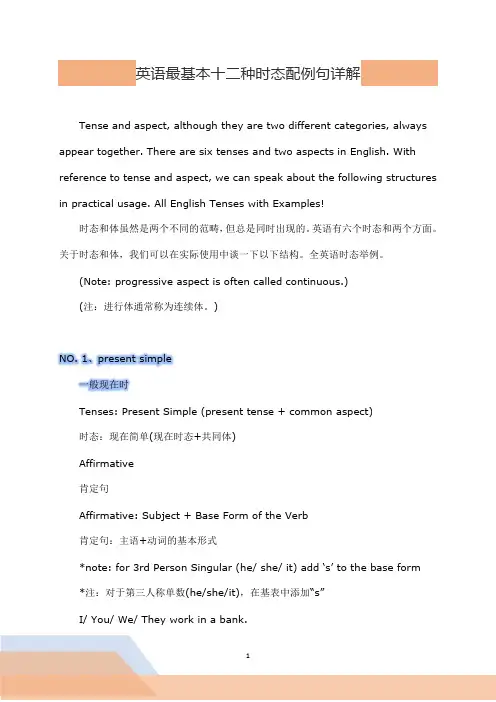
英语最基本十二种时态配例句详解Tense and aspect, although they are two different categories, always appear together. There are six tenses and two aspects in English. With reference to tense and aspect, we can speak about the following structures in practical usage. All English Tenses with Examples!时态和体虽然是两个不同的范畴,但总是同时出现的。
英语有六个时态和两个方面。
关于时态和体,我们可以在实际使用中谈一下以下结构。
全英语时态举例。
(Note: progressive aspect is often called continuous.)(注:进行体通常称为连续体。
)NO. 1、present simple一般现在时Tenses: Present Simple (present tense + common aspect)时态:现在简单(现在时态+共同体)Affirmative肯定句Affirmative: Subject + Base Form of the Verb肯定句:主语+动词的基本形式*note: for 3rd Person Singular (he/ she/ it) add ‘s’ to the base form*注:对于第三人称单数(he/she/it),在基表中添加“s”I/ You/ We/ They work in a bank.我/你/我们/他们在银行工作。
He/ She works in a bank.他/她在银行工作。
Negative否定句Negative: Subject + don’t/ doesn’t + Base Form of the Verb动词:主语+don’t/ doesn’t +动词的基本形式I/ You/ We/ They don’t (do not) work.我/你/我们/他们不工作。
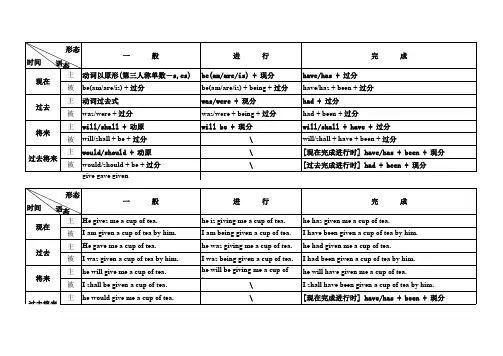
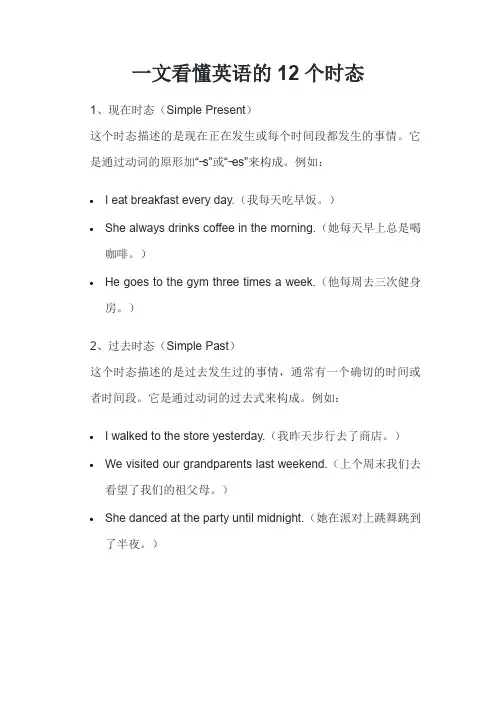
一文看懂英语的12个时态1、现在时态(Simple Present)这个时态描述的是现在正在发生或每个时间段都发生的事情。
它是通过动词的原形加“-s”或“-es”来构成。
例如:•I eat breakfast every day.(我每天吃早饭。
)•She always drinks coffee in the morning.(她每天早上总是喝咖啡。
)•He goes to the gym three times a week.(他每周去三次健身房。
)2、过去时态(Simple Past)这个时态描述的是过去发生过的事情,通常有一个确切的时间或者时间段。
它是通过动词的过去式来构成。
例如:•I walked to the store yesterday.(我昨天步行去了商店。
)•We visited our grandparents last weekend.(上个周末我们去看望了我们的祖父母。
)•She danced at the party until midnight.(她在派对上跳舞跳到了半夜。
)3、将来时态(Simple Future)这个时态描述的是将来要发生的事情。
它可以使用“will + 动词的原形”或“be going to + 动词的原形”来构成。
例如:•I will study hard for the test next week.(我下周会为考试努力学习。
)•She is going to travel to Europe next summer.(她下个夏天要去欧洲旅行。
)•They will have their graduation ceremony next month.(他们下个月会举行毕业典礼。
)4、现在进行时态(Present Continuous)这个时态描述的是正在进行的动作或状态。
它是通过be动词(am/is/are)加上动词的现在分词(-ing形式)来构成。
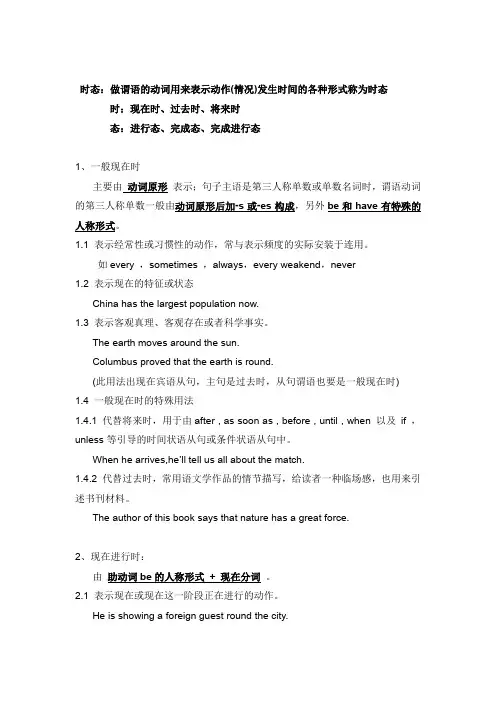
时态:做谓语的动词用来表示动作(情况)发生时间的各种形式称为时态时:现在时、过去时、将来时态:进行态、完成态、完成进行态1、一般现在时主要由动词原形表示;句子主语是第三人称单数或单数名词时,谓语动词的第三人称单数一般由动词原形后加-s或-es构成,另外be和have有特殊的人称形式。
1.1 表示经常性或习惯性的动作,常与表示频度的实际安装于连用。
如every ,sometimes ,always,every weakend,never1.2 表示现在的特征或状态China has the largest population now.1.3 表示客观真理、客观存在或者科学事实。
The earth moves around the sun.Columbus proved that the earth is round.(此用法出现在宾语从句,主句是过去时,从句谓语也要是一般现在时)1.4 一般现在时的特殊用法1.4.1 代替将来时,用于由after , as soon as , before , until , when 以及if ,unless等引导的时间状语从句或条件状语从句中。
When he arrives,he’ll tell us all about the match.1.4.2 代替过去时,常用语文学作品的情节描写,给读者一种临场感,也用来引述书刊材料。
The author of this book says that nature has a great force.2、现在进行时:由助动词be的人称形式+ 现在分词。
2.1 表示现在或现在这一阶段正在进行的动作。
He is showing a foreign guest round the city.2.2 表示一个在最近按计划或安排要进行的动作。
(这时多有一个表示未来时间的状语)A foreigner is giving a lecture this afternoon.2.3 代替一般现在时,表示一个经常性的状态。
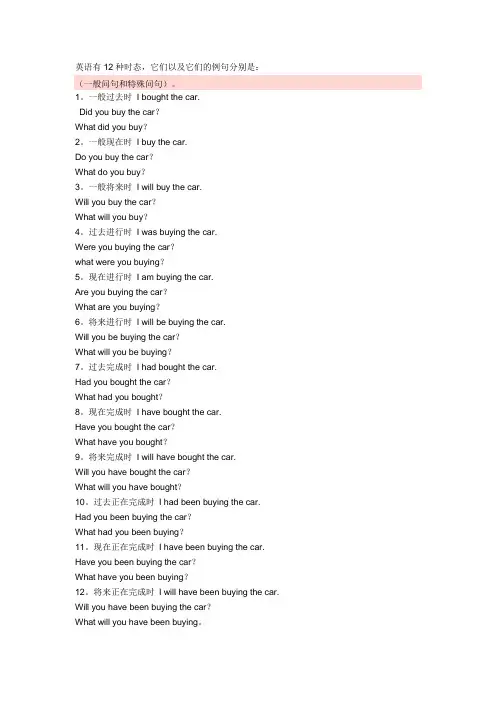
英语有12种时态,它们以及它们的例句分别是:(一般问句和特殊问句)。
1。
一般过去时I bought the car.Did you buy the car?What did you buy?2。
一般现在时I buy the car.Do you buy the car?What do you buy?3。
一般将来时I will buy the car.Will you buy the car?What will you buy?4。
过去进行时I was buying the car.Were you buying the car?what were you buying?5。
现在进行时I am buying the car.Are you buying the car?What are you buying?6。
将来进行时I will be buying the car.Will you be buying the car?What will you be buying?7。
过去完成时I had bought the car.Had you bought the car?What had you bought?8。
现在完成时I have bought the car.Have you bought the car?What have you bought?9。
将来完成时I will have bought the car.Will you have bought the car?What will you have bought?10。
过去正在完成时I had been buying the car. Had you been buying the car?What had you been buying?11。
现在正在完成时I have been buying the car. Have you been buying the car?What have you been buying?12。
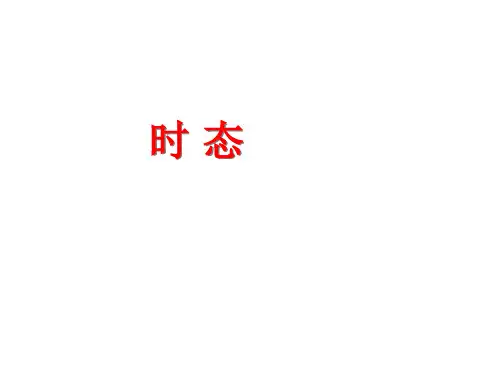
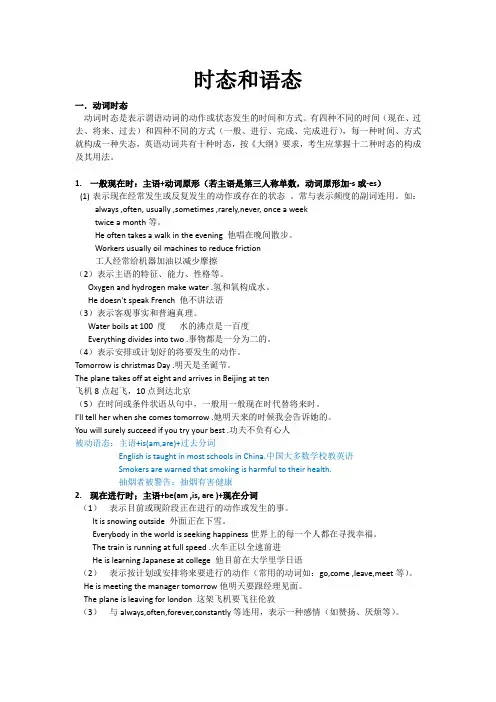
时态和语态一.动词时态动词时态是表示谓语动词的动作或状态发生的时间和方式。
有四种不同的时间(现在、过去、将来、过去)和四种不同的方式(一般、进行、完成、完成进行),每一种时间、方式就构成一种失态,英语动词共有十种时态,按《大纲》要求,考生应掌握十二种时态的构成及其用法。
1.一般现在时:主语+动词原形(若主语是第三人称单数,动词原形加-s或-es)(1)表示现在经常发生或反复发生的动作或存在的状态。
常与表示频度的副词连用。
如:always ,often, usually ,sometimes ,rarely,never, once a weektwice a month等。
He often takes a walk in the evening 他唱在晚间散步。
Workers usually oil machines to reduce friction工人经常给机器加油以减少摩擦(2)表示主语的特征、能力、性格等。
Oxygen and hydrogen make water .氢和氧构成水。
He doesn’t speak French 他不讲法语(3)表示客观事实和普遍真理。
Water boils at 100 度水的沸点是一百度Everything divides into two .事物都是一分为二的。
(4)表示安排或计划好的将要发生的动作。
Tomorrow is christmas Day .明天是圣诞节。
The plane takes off at eight and arrives in Beijing at ten飞机8点起飞,10点到达北京(5)在时间或条件状语从句中,一般用一般现在时代替将来时。
I’ll tell her when she comes tomorrow .她明天来的时候我会告诉她的。
You will surely succeed if you try your best .功夫不负有心人被动语态:主语+is(am,are)+过去分词English is taught in most schools in China.中国大多数学校教英语Smokers are warned that smoking is harmful to their health.抽烟者被警告:抽烟有害健康2.现在进行时;主语+be(am ,is, are )+现在分词(1)表示目前或现阶段正在进行的动作或发生的事。
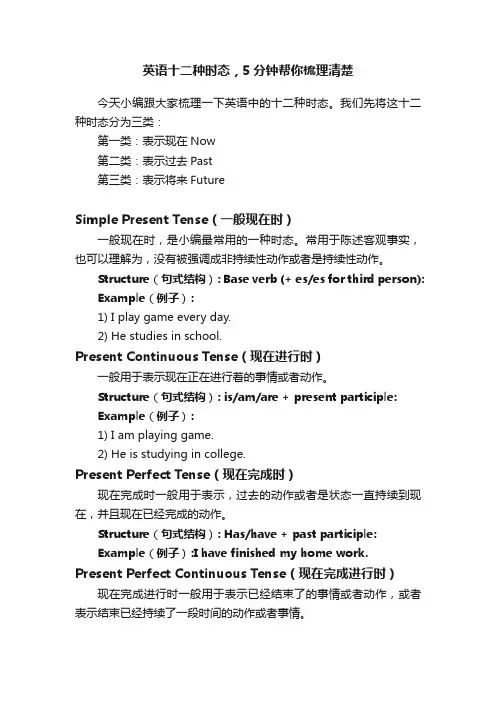
英语十二种时态,5分钟帮你梳理清楚今天小编跟大家梳理一下英语中的十二种时态。
我们先将这十二种时态分为三类:第一类:表示现在Now第二类:表示过去Past第三类:表示将来FutureSimple Present Tense(一般现在时)一般现在时,是小编最常用的一种时态。
常用于陈述客观事实,也可以理解为,没有被强调成非持续性动作或者是持续性动作。
Structure(句式结构): Base verb (+ es/es for third person): Example(例子):1) I play game every day.2) He studies in school.Present Continuous Tense(现在进行时)一般用于表示现在正在进行着的事情或者动作。
Structure(句式结构): is/am/are + present participle:Example(例子):1) I am playing game.2) He is studying in college.Present Perfect Tense(现在完成时)现在完成时一般用于表示,过去的动作或者是状态一直持续到现在,并且现在已经完成的动作。
Structure(句式结构): Has/have + past participle:Example(例子):I have finished my home work. Present Perfect Continuous Tense(现在完成进行时)现在完成进行时一般用于表示已经结束了的事情或者动作,或者表示结束已经持续了一段时间的动作或者事情。
Structure(句式结构): Has/have + been + present participle:Example(例子):1) I have been finishing my home work for the last two hours.2) He has been studying in school since his childhood.Simple Past Tense(一般过去时)一般过去时一般用于表示在过去的时候发生过了的动作,或者在过去的时候有过的状态。
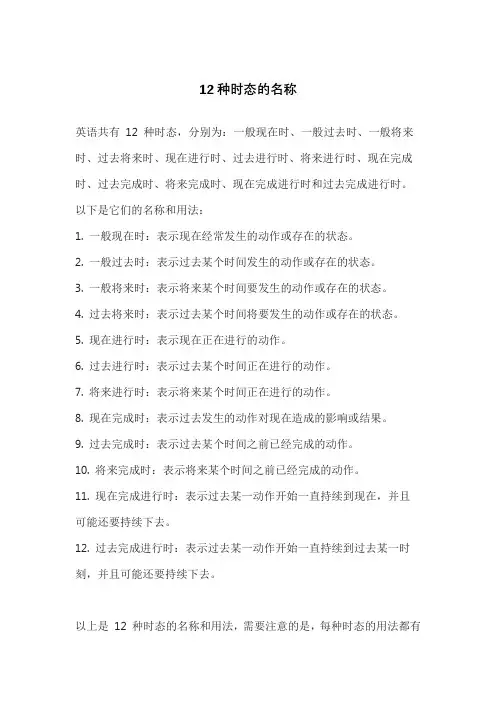
12种时态的名称
英语共有12 种时态,分别为:一般现在时、一般过去时、一般将来时、过去将来时、现在进行时、过去进行时、将来进行时、现在完成时、过去完成时、将来完成时、现在完成进行时和过去完成进行时。
以下是它们的名称和用法:
1. 一般现在时:表示现在经常发生的动作或存在的状态。
2. 一般过去时:表示过去某个时间发生的动作或存在的状态。
3. 一般将来时:表示将来某个时间要发生的动作或存在的状态。
4. 过去将来时:表示过去某个时间将要发生的动作或存在的状态。
5. 现在进行时:表示现在正在进行的动作。
6. 过去进行时:表示过去某个时间正在进行的动作。
7. 将来进行时:表示将来某个时间正在进行的动作。
8. 现在完成时:表示过去发生的动作对现在造成的影响或结果。
9. 过去完成时:表示过去某个时间之前已经完成的动作。
10. 将来完成时:表示将来某个时间之前已经完成的动作。
11. 现在完成进行时:表示过去某一动作开始一直持续到现在,并且可能还要持续下去。
12. 过去完成进行时:表示过去某一动作开始一直持续到过去某一时刻,并且可能还要持续下去。
以上是12 种时态的名称和用法,需要注意的是,每种时态的用法都有
一些细节和特殊情况,需要根据具体语境来理解和使用。
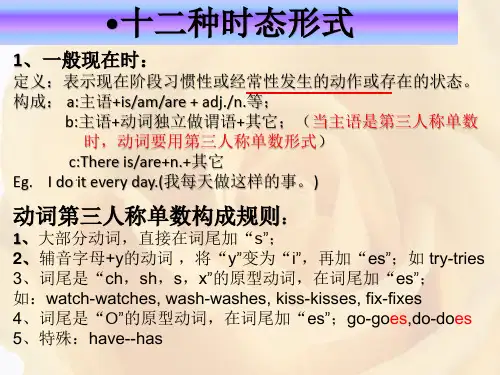
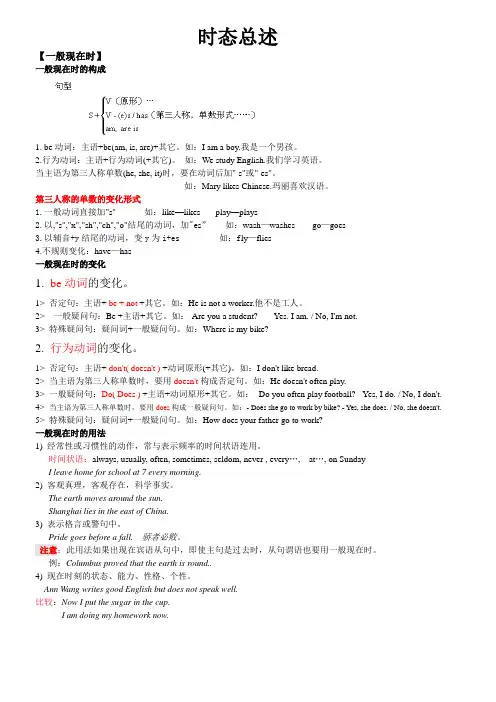
时态总述【一般现在时】一般现在时的构成1. be动词:主语+be(am, is, are)+其它。
如:I am a boy.我是一个男孩。
2.行为动词:主语+行为动词(+其它)。
如:We study English.我们学习英语。
当主语为第三人称单数(he, she, it)时,要在动词后加"-s"或"-es"。
如:Mary likes Chinese.玛丽喜欢汉语。
第三人称的单数的变化形式1.一般动词直接加"s" 如:like—likes play—plays2.以,"s","x","sh","ch","o"结尾的动词,加"e s”如:wash—washes go—goes3.以辅音+y结尾的动词,变y为i+es 如:f ly—flies4.不规则变化:have—has一般现在时的变化1.be动词的变化。
1> 否定句:主语+ be + not +其它。
如:He is not a worker.他不是工人。
2> 一般疑问句:Be +主语+其它。
如:-Are you a student? -Y es. I am. / No, I'm not.3> 特殊疑问句:疑问词+一般疑问句。
如:Where is my bike?2.行为动词的变化。
1> 否定句:主语+ don't( doesn't ) +动词原形(+其它)。
如:I don't like bread.2> 当主语为第三人称单数时,要用doesn't构成否定句。
如:He doesn't often play.3> 一般疑问句:Do( Does ) +主语+动词原形+其它。
如:- Do you often play football? - Yes, I do. / No, I don't.4> 当主语为第三人称单数时,要用does构成一般疑问句。
时态TenseImportant :在英文句子中,一个句子只有一个谓语动词,不可能同有do又有be,一个正确的句子只能二者选其一。
有动作时,第一人称以及复数主语的谓语用do (指所有的动词原形),第三人称以及其它单数主语用does作谓语(指所有的动词单数形式)。
在句子没有动作发生的情况下,用主系表结构。
系动词be ( is, am, are, was, were, been, be)。
时间time +动作action =时态tense :do:be:在所有的句子中,只能有一个谓语动词。
在所有的问句中,第一个动词有人称和数的变化,第二个动词一定是动词原形。
Should是shall的过去分词,would是will的过去分词。
在日常生活中,看到的东西不会说时,只能用it, this, that, these, those来代替。
在英语习惯中,地点一般不作为主语存在,它一般在句子中作地点状语。
回答一般疑问句,肯定时一定是用yes来回答,否定一定是用No来回答。
在is there的句型中,肯定回答是yes, there is. 否定的回答是no, there is not. 在回答is this和is that 的句子中,this和that要改成it来回答。
Are these和are thoes以及are they的回答时these, those, they都要用they来回答。
Be和do在不同时态中的区分:Do: 在问句中,只有Do, 没有does.一般现在时:My English gets beter and better.一般过去时:My English got better last year.一般将来时:My English will get better and better.现在完成时:My english has got better.Be:一般现在时:My english is better.一般过去时:My english was better.一般将来时:My english will be better. Or:I am going to find a new job.现在完成时:My english has been better.现在进行时只有一种形式:is/ am/ are + 现在分词.在将来时中,will do和be going to do中的do是任何一个动词原形且一定是动词原形。
英语中共有12种时态,包括4种基本时态和8种复合时态。
以下是详细归纳所有时态,并举例说明:现在时(Simple Present Tense)表示现在正在进行的动作或状态,或表示经常性、习惯性的动作或状态。
例句:I usually go to the gym after work.(我通常下班后去健身房。
)She loves to read books.(她喜欢读书。
)过去时(Simple Past Tense)表示过去发生的动作或状态。
例句:I went to New York last month.(我上个月去了纽约。
)She studied hard for the exam.(她为考试努力学习。
)将来时(Simple Future Tense)表示将来要发生的动作或状态。
例句:We will have a meeting tomorrow.(我们明天将开会。
)She is going to visit her parents next week.(她下周将去拜访她的父母。
)现在进行时(Present Continuous Tense)表示现在正在进行的动作。
例句:He is playing basketball now.(他现在正在打篮球。
)She is studying English at the moment.(她此刻正在学习英语。
)过去进行时(Past Continuous Tense)表示过去正在进行的动作。
例句:I was watching TV when he called.(他打电话时我正在看电视。
)She was cooking dinner at 7pm yesterday.(昨天晚上7点她在煮晚餐。
)将来进行时(Future Continuous Tense)表示将来某个时间正在进行的动作。
例句:I will be studying at this time tomorrow.(明天此时我将在学习。
时态Tense(16种,常见12种)一、一般现在时:由动词原形构成(第三人称单数做主语时,谓语动词加s/es)1.表示经常性、习惯性或反复发生的动作,常与often, usually, always, sometimes, once a week,never, occasionally, rarely, generally, now and then等时间状语连用。
e.g. She always takes a walk in the evening.My hens often fly over the wall and lay eggs in his garden.2.表示客观事实或普遍真理。
e.g. The sun rises in the east and sets in the west.Time and tide wait for no man.3.表示按规定、计划将要发生的动作或事件,常用的动词有:go, come, leave, arrive, begin, start,stay等。
e.g. Our summer vacation begins in early July.The plane leaves for Hongkong this evening.二、一般过去时:由动词过去式构成(动词be有was, were)1.表示过去特定时间发生的动作或情况,过去的时间状语可具体指明,也可不指明。
e.g. I attended a meeting of the committee last week.He cut a few slices of sausage and tore a large chunk from a loaf ofcrispcrusted bread.2.表示现在的时间,使句子语气委婉。
常用动词有:hope, want, wonder, think, intend等。
【整理】英语16种时态表一、一般现在时一般现在时表示经常发生或习惯性的动作、状态或真理。
其结构为:主语 + 动词原形(第三人称单数加s/es)。
例句:He goes to school bike every day.(他每天骑自行车上学。
)二、一般过去时一般过去时表示过去某个时间发生的动作或存在的状态。
其结构为:主语 + 动词过去式。
例句:I visited the Great Wall last year.(去年我参观了长城。
)三、一般将来时一般将来时表示将来某个时间会发生的动作或存在的状态。
其结构为:will + 动词原形。
例句:She will graduate from college next year.(她明年将大学毕业。
)四、现在进行时现在进行时表示正在进行的动作或状态。
其结构为:主语 + be动词(am/is/are) + 现在分词。
例句:They are watching a movie in the cinema.(他们正在电影院看电影。
)五、过去进行时过去进行时表示在过去某个时间正在进行的动作或状态。
其结构为:主语 + was/were + 现在分词。
例句:She was reading a book when I called her.(我给她打电话时,她正在看书。
)六、将来进行时将来进行时表示将来某个时间正在进行的动作或状态。
其结构为:will be + 现在分词。
例句:In two hours, we will be sitting in the classroom.(两小时后,我们将坐在教室里。
)七、现在完成时现在完成时表示过去发生的动作对现在造成的影响或结果,常与时间状语since, for, already, yet等连用。
其结构为:主语 +have/has + 过去分词。
例句:She has already finished her homework.(她已经完成了她的家庭作业。
英语常见时态英语常见时态有16种,分别是:一般现在时、现在进行时、现在完成时、现在完成进行时、过去将来时、过去完成时、过去完成进行时、过去将来完成时、过去将来进行时、过去进行时、将来进行时、现在完成进行时、过去完成进行时、将来完成时、将来完成进行时、过去将来完成进行时。
一般现在时:表示现在经常反复发生的动作、状态或特征。
现在进行时:表示正在进行的动作或存在的状态。
现在完成时:表示已经完成的动作或存在的状态对现在造成的影响或结果。
现在完成进行时:表示从过去某一时间开始一直延续到现在的动作或状态,强调这个动作或状态在现在仍在继续。
过去将来时:表示从过去的某个时间来看将来会发生什么事情。
过去完成时:表示在过去某个时间之前已经完成的动作或状态。
过去完成进行时:表示从过去某一时间开始一直延续到过去另一时间的动作或状态,强调这个动作或状态在后一个时间仍在继续。
过去将来完成时:表示从过去的某个时间来看将来会完成的动作或状态。
过去将来进行时:表示从过去的某个时间来看将来正在进行的动作或状态。
过去进行时:表示在过去某个时间正在进行的动作或存在的状态。
将来进行时:表示在将来某个时间正在进行的动作或存在的状态。
现在完成进行时:表示从过去某一时间开始一直延续到现在的动作或状态,强调这个动作或状态在现在仍在继续。
过去完成进行时:表示从过去某一时间开始一直延续到过去另一时间的动作或状态,强调这个动作或状态在后一个时间仍在继续。
将来完成时:表示在将来某个时间会完成的动作或状态。
将来完成进行时:表示从将来的某个时间开始一直延续到将来的某个时间的动作或状态,强调这个动作或状态在将来仍在继续。
过去将来完成进行时:表示从过去的某个时间来看将来会一直延续到未来的某个时间的动作或状态,强调这个动作或状态在未来的那个时间仍在继续。
英语时态大全(Tense)。
词形变化的形式共有如下四种:1.一般式(Simple Form)2.进行式(Progressive Form)3.完成式(Perfect Form)4.完成进行式(Perfect Progressive Form)动作或状态的时间性则可分为如下三个时段:1.现在(Present)2.过去(Past)3.将来(Future)这四种词形形式和三个时段可以配合成如下的十二种动词的时态。
这十二种时态可以列表如下:现以“I”为主语,“do”为动词,把这十二种时态以实例表达如下:(例序即为时态的次序)1.I do it every day.(我每天做这样的事。
)2.I did it yesterday.(昨天我做了这件事。
)3.I shall/will do it tomorrow.(明天我要做这件事。
)4.I am doing it now.(现在我正在做这件事。
)5.I was doing it at that time.(当时我正在做这件事。
)6.I shall/will be doing it at 9:00 tomorrow morning.(明天早晨九时我会正在做这件事。
)7.I have done it already.(我已把这件事做好了。
)8.I have done it before I went home yesterday.(昨天我在回家之前就把那件工作做完了。
)9.I shall/will have done it before you come backtomorrow.(明天在我回来之前我会把这件工作做好。
)10.I have been doing it for two days.(这件工作我已做了两天了。
──说话时工作尚未做完,所以还得继续做。
)11.I had been doing the work for two hours when theteacher came.(老师来时那件工作我已做了两小时了。